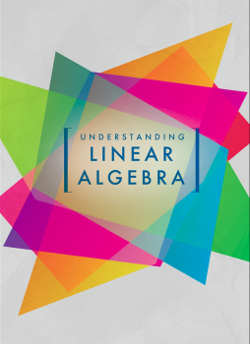Suppose that \(W\) is the \(2\)-dimensional subspace of \(\real^5\) with basis
\begin{equation*}
\wvec_1=\fivevec{-1}{-2}23{-4},\hspace{24pt}
\wvec_2=\fivevec24202\text{.}
\end{equation*}
We will give a description of the orthogonal complement \(W^\perp\text{.}\)
If \(\xvec\) is in \(W^\perp\text{,}\) we know that \(\xvec\) is orthogonal to both \(\wvec_1\) and \(\wvec_2\text{.}\) Therefore,
\begin{align*}
\wvec_1\cdot\xvec \amp {}={}-x_1-2x_2+2x_3+3x_4-4x_5
\amp {}={} 0\\
\wvec_2\cdot\xvec \amp {}={} 2x_1+4x_2+2x_3+0x_4+2x_5
\amp {}={} 0
\end{align*}
In other words, \(B\xvec=\zerovec\) where
\begin{equation*}
B =
\begin{bmatrix}
-1 \amp -2 \amp 2 \amp 3 \amp -4 \\
2 \amp 4 \amp 2 \amp 0 \amp 2
\end{bmatrix}
\sim
\begin{bmatrix}
1 \amp 2 \amp 0 \amp -1 \amp 2 \\
0 \amp 0 \amp 1 \amp 1 \amp -1
\end{bmatrix}\text{.}
\end{equation*}
The solutions may be described parametrically as
\begin{equation*}
\xvec=\fivevec{x_1}{x_2}{x_3}{x_4}{x_5}
=x_2\fivevec{-2}1000 + x_4\fivevec10{-1}10 +
x_5\fivevec{-2}0101\text{.}
\end{equation*}
The distributive property of dot products implies that any vector that is orthogonal to both \(\wvec_1\) and \(\wvec_2\) is also orthogonal to any linear combination of \(\wvec_1\) and \(\wvec_2\) since
\begin{equation*}
(c_1\wvec_1 + c_2\wvec_2)\cdot\xvec = c_1\wvec_1\cdot\xvec +
c_2\wvec_2\cdot\xvec = 0\text{.}
\end{equation*}
Therefore, \(W^\perp\) is a \(3\)-dimensional subspace of \(\real^5\) with basis
\begin{equation*}
\vvec_1=\fivevec{-2}1000, \hspace{24pt}
\vvec_2=\fivevec10{-1}10, \hspace{24pt}
\vvec_3=\fivevec{-2}0101\text{.}
\end{equation*}
One may check that the vectors \(\vvec_1\text{,}\) \(\vvec_2\text{,}\) and \(\vvec_3\) are each orthogonal to both \(\wvec_1\) and \(\wvec_2\text{.}\)





